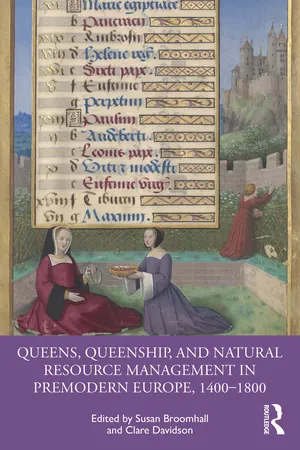
Queens, Queenship, and Natural Resource Management in Premodern Europe, 1400-1800
- 376 pages
- English
- ePUB (mobile friendly)
- Available on iOS & Android
Queens, Queenship, and Natural Resource Management in Premodern Europe, 1400-1800
About this book
This innovative collection examines how European queens participated in the conceptualisation, mobilisation, and transformation of 'natural resources' from the fifteenth to the end of the eighteenth century.
Early modern queens interacted with human and nonhuman worlds through natural resource management activities that have rarely been the focus of sustained historical analysis. This volume engages with the wide range of nonhuman materials, living and inanimate, that premodern queens had the power to direct and dispose of, to utilise, enjoy, and commercialise, to visualise and commemorate, and even to destroy, on and in their lands, forests, waterways, and oceans. Both queenship and natural resource management were configured by contemporary gender ideologies, which structured a dynamic relationship between queenship and the more-than-human world. The case studies in this collection explore how queens' natural resource management was impacted by their cultural and personal contexts, particularly their changing status as queens regnant, consort, dowager, or regent. The contributors draw on diverse materials and employ a variety of historical approaches—including political, economic, cultural, literary, legal, and animal studies—to demonstrate how queens interacted with the nonhuman world and how their engagements were embedded in premodern gender rules.
This collection will be of great value for undergraduate and postgraduate students, and scholars, in gender and women's history, environmental history, queenship studies, and early modern studies.
Frequently asked questions
- Essential is ideal for learners and professionals who enjoy exploring a wide range of subjects. Access the Essential Library with 800,000+ trusted titles and best-sellers across business, personal growth, and the humanities. Includes unlimited reading time and Standard Read Aloud voice.
- Complete: Perfect for advanced learners and researchers needing full, unrestricted access. Unlock 1.4M+ books across hundreds of subjects, including academic and specialized titles. The Complete Plan also includes advanced features like Premium Read Aloud and Research Assistant.
Please note we cannot support devices running on iOS 13 and Android 7 or earlier. Learn more about using the app.
Information
Table of contents
- Cover
- Half Title
- Title Page
- Copyright Page
- Table of Contents
- List of Figures
- List of Maps
- List of Contributors
- Acknowledgements
- 1 Queens, Queenship, and Natural Resource Management in a More-Than-Human Premodern World
- 2 Preserving the Queen’s Resources, Pressing Ancient Privileges: Joan of Navarre and the Management of Forest and Parklands
- 3 Barbara of Cilli, Joanna of Rožmitál, and the Management of Dowry Towns in Fifteenth-Century Bohemia
- 4 Sovereign Hybridities: Anne of Brittany, Claude of France, and More-Than-Human Resource Management at the château of Blois
- 5 Catherine of Aragon, the Forest, and Hunting: Princess, Bride, Dowager Princess, Queen Consort
- 6 Redefining Resource Stewardship in the Interest of the Dynasty: Bona Sforza’s Innovations in Poland and Lithuania
- 7 Catherine of Austria (1507–78), the Arara, and the Colonisation of Brazilian Natural Resources
- 8 Queen Elizabeth’s Mineral Grants: How Corporate Monarchy and Corporate Mining Structured Natural Resource Policy in Sixteenth-Century England and Beyond
- 9 Anna Jagiellon’s Forest Management: Legal Bases, Methods of Governance and Exploitation
- 10 The Soap-makers and the Queen: The Rhetoric of Maternalism in the ‘Oil Affairs’ of Late Sixteenth-Century England
- 11 A Danish Queen as Industrial Entrepreneur: Charlotte Amalie of Hessen-Kassel and Her Lands
- 12 Queen Charlotte and the Colonies: Queenly Agency in Collecting Australia’s Flora and Fauna
- Index